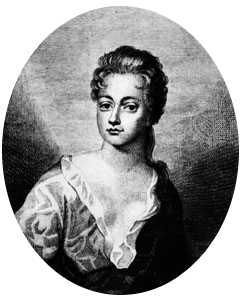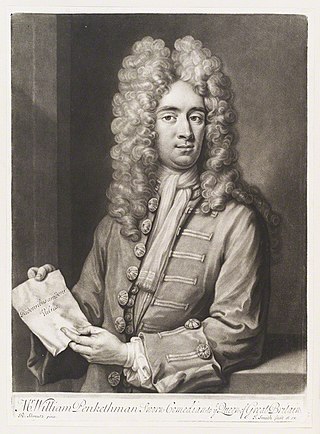Related Research Articles
This article contains information about the literary events and publications of 1700.
Events from the year 1703 in literature.
This article contains information about the literary events and publications of 1705.
This article contains information about the literary events and publications of 1701.
This article contains information about the literary events and publications of 1699.
This article contains information about the literary events and publications of 1698.
This article contains information about the literary events and publications of 1697.
Barton Booth was one of the most famous dramatic actors of the first part of the 18th century.

Anne Bracegirdle was an English actress and soprano. Most of the plays she performed in involved singing as well as acting. She often performed music written for her by the composer John Eccles, and also sung music written for her by Henry Purcell. She became particularly well known for the song "I burn" which Eccles originally wrote for Bracegirdle to perform in Thomas D'Urfey's play The Comical History of Don Quixote (1694). She also sang music by Eccles in the play The Richmond Heiress (1693) and in William Congreve opera The Judgment of Paris. In 1706 she starred in Giuseppe Fedeli's opera The Temple of Love.
Mary Kent was an English actress, whose career lasted from 1692 to 1718. Her dates of birth and death are not known. She was the wife of Drury Lane actor Thomas Kent.

Robert Wilks was a British actor and theatrical manager who was one of the leading managers of Theatre Royal, Drury Lane in its heyday of the 1710s. He was, with Colley Cibber and Thomas Doggett, one of the "triumvirate" of actor-managers that was denounced by Alexander Pope and caricatured by William Hogarth as leaders of the decline in theatrical standards and degradation of the stage's literary tradition.

Lisle's Tennis Court was a building off Portugal Street in Lincoln's Inn Fields in London. Originally built as a real tennis court, it was used as a playhouse during two periods, 1661–1674 and 1695–1705. During the early period, the theatre was called Lincoln's Inn Fields Playhouse, also known as The Duke's Playhouse, The New Theatre or The Opera. The building was rebuilt in 1714, and used again as a theatre for a third period, 1714–1732. The tennis court theatre was the first public playhouse in London to feature the moveable scenery that would become a standard feature of Restoration theatres.
Events from the year 1699 in England.

William Pinkethman was an English comic actor, a low comedian with a droll style, and theatre manager. He was considered an imitator of Anthony Leigh.
John Mills (c.1670–1736) was a British stage actor. A long-standing part of the Drury Lane company from 1695 until his death, he appeared in both comedies and tragedies. His wife Margaret Mills was an actress, and his son William Mills also became an actor at Drury Lane.
Thomas Simpson was an English stage actor of the late seventeenth and early eighteenth century. His surname is sometimes written as Sympson.
Benjamin Husband was a British stage actor of the eighteenth century. His surname is sometimes written as Husbands.
Mary Willis was a British stage actress of the eighteenth century.
George Pack was a British stage actor, singer and theatre manager of the eighteenth century. His first known performance on the London stage was as Westmoreland in Shakespeare's Henry IV at the Lincoln's Inn Fields Theatre and he remained with the company until it transferred to the Queens's Theatre in the Haymarket in 1705. He played in a mixture of comedies and tragedies, originating roles in plays by many of the leading dramatists of the era including Nicholas Rowe, Mary Pix, John Vanbrugh and Susanna Centlivre.
Philip Griffin was an English stage actor of the seventeenth century and early eighteenth century. He joined the King's Company at Drury Lane during the 1670s, and was later a member of the merged United Company from 1685. He was named as a manager at Drury Lane in 1695, but then took military service and was styled as Captain Griffin. In 1699 he went to act in Dublin as part of Joseph Ashbury's company at the Smock Alley Theatre, but was back in London where he acted until retired from the stage in 1707.
References
- ↑ Penguin Pocket On This Day. Penguin Reference Library. 2006. ISBN 0-14-102715-0.
- ↑ William J. Burling (1992). A Checklist of New Plays and Entertainments on the London Stage, 1700-1737. Fairleigh Dickinson Univ Press. p. 66. ISBN 978-0-8386-3451-6.
- ↑ Philip B. Meggs; Alston W. Purvis (16 May 2016). Meggs' History of Graphic Design. John Wiley & Sons. p. 46. ISBN 978-1-119-13623-1.
- ↑ Palmer, Alan; Palmer, Veronica (1992). The Chronology of British History. London: Century Ltd. pp. 201–202. ISBN 0-7126-5616-2.
- ↑ As "Narrow Road to the Interior", Bolitho, Harold (2003), in Treasures of the Yenching: seventy-fifth anniversary of the Harvard-Yenching Library, Chinese University Press. ISBN 978-962-996-102-2. p. 35.
- ↑ William Austin (1928). The History of Luton and Its Hamlets: Being a History of the Old Parish and Manor of Luton in Bedfordshire. County Press. p. 43.